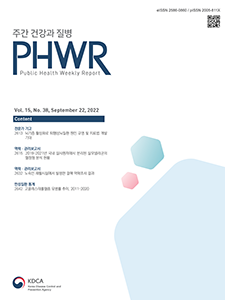Current Issue
Vol.15 No.38, September 22, 2022
-
Epidemiology and Surveillance 2022-09-22
 1
1
 3774
3774
 957
957
Trends in Serotype Distribution of Salmonella enterica Isolated from Diarrheal Patients in Korea, 2019 to 2021
Hyun Ju Jeong, Eunkyung Shin, Jungsun Park, JooHyun Han, Junyoung Kim, Jaeil Yoo*
Public Health Weekly Report 2022; 15(38): 2615-2631 https://doi.org/10.56786/PHWR.2022.15.38.2615 Abstract
AbstractSalmonella is a common pathogen causing water- and foodborne diseases worldwide. This pathogen typically spreads through contaminated water and food. Infection outbreaks are typified by main symptoms including diarrhea, fever, chills, and vomiting. We analyzed the prevalence and characteristics of Salmonella strains isolated from the Enteric Pathogens Active Surveillance Network (Enter-Net) from 2019 to 2021. A total of 1,872 Salmonella strains were isolated from domestic residents (1,789 strains) and returning travelers (83 strains) in Korea using Enter-Net. The identified Salmonella strains showed 100 serotypes, the most common being Salmonella Enteritidis 379 (20.2%), Salmonella Typhimurium 357 (19.1%), and Salmonella I 4,[5],12:i:- 301 (16.1%), most of which were caused by Salmonella Enteritidis and Salmonella Typhimurium. The imported strains were isolated from patients with diarrhea who returned from the Philippines, Vietnam, China, Thailand, and Indonesia. Indentified serotypes, such as Salmonella Newport, Salmonella Anatum, Salmonella Stanley and Salmonella Derby, of imported strains showed a higher isolation rate than serotypes of domestic strains. Three serotypes, Salmonella Amagar, Salmonella Duesseldorf, and Salmonella Kottbus, have never been isolated in Korea. The results of monthly isolation rate showed that the risk of Salmonella infection increases from March to October, and it is necessary to prevent and manage food poisoning outbreaks, with particular focus in warmer seasons. This study aimed to provide information on the distribution of the prevalent Salmonella serotypes isolated from patients with diarrhea over the past 3 years through the national pathogen monitoring system, for addressing and preventing outbreaks of infectious diseases.
-
Epidemiology and Surveillance 2022-09-22
 0
0
 431
431
 156
156
Results of Tuberculosis Contact Investigation in a Homeless Rehabilitation Facility
Juyoung Park, Aejung Lee, Jin Kim, Eunyoung Kim, Jeonghee Yu*
Public Health Weekly Report 2022; 15(38): 2632-2641 https://doi.org/10.56786/PHWR.2022.15.38.2632AbstractTuberculosis (TB) is caused by Mycobacterium tuberculosis and is transmitted through air. Transmission depends on proximity and exposure time. In October 2021, this facility reported by two residents with TB, and 188 people, such as staff who contacted patients with TB and other residents were tested for TB. Two additional patients with TB were identified along with 59 cases of latent tuberculosis infection ( LTBI). Generally, proximity and exposure time increases the rate of infection in vulnerable groups such as the homeless population. People in this population share their living spaces and have frequent contact with each other. This circumstance resulted in high rates of TB infection or LTBI. This study investigated TB in homeless shelters. We attempted to determine a method for early detection and additional transmission in contact with patients with TB. We also provide a method for the detection and treatment of LTBI. In conclusion, we aimed to prevent and manage TB in this vulnerable group through education. Thus, residents and workers in shelters should be educated on TB information in the community.
-
Noncommunicable Disease Statistics 2022-09-22
 0
0
 906
906
 306
306
Trends in Prevalence of Hypercholesterolemia, 2011–2020
Public Health Weekly Report 2022; 15(38): 2642-2643 https://doi.org/10.56786/PHWR.2022.15.38.2642

pp. 1433~1461
Most Keyword
?
What is Most Keyword?
- It is the most frequently used keyword in articles in this journal for the past two years.
Most Read
-
Waterborne and Foodborne Disease Outbreaks in the Republic of Korea, 2023
Myung-Jae Hwang, So Yeon Park, Hyungjun Kim, Se Jeong Yang, Sungchan Yang, Jin Seon Yang
Public Health Weekly Report 2025;18: 17-32 https://doi.org/10.56786/PHWR.2025.18.1.2 -
Implementation Plan for the Coronavirus Disease 2019 Vaccination for the 2024–2025 Season: Recommendations of the 6th Expert Committee on Immunization Practices
Hyewook Hwang, Wookeon Lee, Seohyeon Ahn, Young-Sook Choi, Seunghyun Lewis Kwon, Dongwoo Lee, Eun Hwa Choi, SokGoo Lee
Public Health Weekly Report 2025;18: 90-102 https://doi.org/10.56786/PHWR.2025.18.2.3
Editorial Office
+82-43-719-7569





 Full Text
Full Text Cite
Cite


